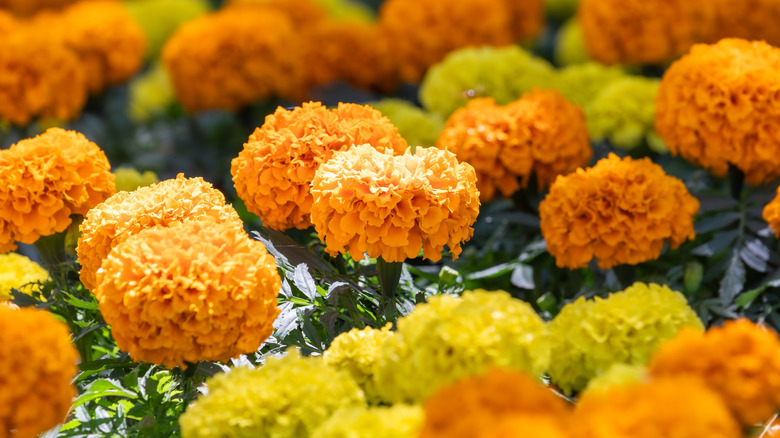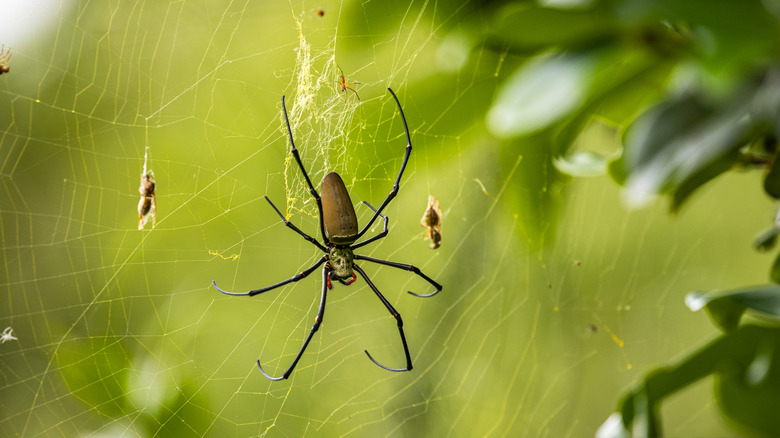Does This Beautiful Indoor Flower Really Keep Spiders Out? Here's What The Science Says
If you despise spiders, then you know the struggle seeing these creepy crawlers make their way into homes and gardens during the autumn season. While most types of spiders commonly seen at home are harmless, the sight of black widows or brown recluses in the cooler months can surely make you feel uneasy. Typical tricks to keep these spiders out include chemical sprays, outdoor pesticides, and electronic repellents. However, if you are looking for a more nature-friendly approach, try marigolds.
Beyond the aesthetics, marigolds, with their vibrant orange, yellow, and even multicolor blooms, can also serve a different purpose. A 2021 study published in BMC Veterinary Research found that these flowers, which belong to the Tagetes genus, emit a potent scent containing alpha-terthienyl, which drives pests away. When activated by ultraviolet light, this compound, also found in chrysanthemums, becomes toxic to different insect species. Marigold's effectiveness against all spider activity is not guaranteed. Even so, since its scent has shown promise in making spaces less inviting to the eight-legged creatures, it is worth trying as a natural hack when it is that time of the year for spiders to seek refuge against cooler temperatures.
Where (and how) to plant marigolds for maximum spider-repelling effect
While planting marigolds in the garden can keep spiders and insects at bay, consider bringing the beautiful flowers inside your home so they can pull double duty as décor and a spider deterrent. The flower has many variants, including those that can grow up to 7 feet tall. Choose the smaller types, such as Safari Scarlet and Discovery Yellow, because they are easier to manage and maintain in small containers. Place them on kitchen counters, near windowsills and doors, or anywhere inside a room if they get adequate light.
To plant marigolds from seeds, use seedling trays or pots with sufficient drainage holes. Fill with nutrient-rich potting mix and then scatter the seeds before lightly covering with another layer of nutrient-dense soil. Water just enough to moisten the top part of the setup since marigolds are sensitive to overwatering and susceptible to root rot. If unsure about the best watering method for marigolds, especially the young ones, use a moisture meter.
Meanwhile, when propagating marigolds from stem cuttings, do not just stab them in the ground and call it a day. You need to submerge the trimmed edges in water first and place them under sunlight for their roots to form. Once they do, transfer the cuts to soil and let them enjoy sunlight at least six hours a day. Supplement with a grow light for days when the sun does not shine.
Other natural spider deterrents aside from marigolds
Although marigolds provide many benefits in the garden, they may not be enough to fully deter spiders from invading your home. An entomology expert who weighed in on the flower's arachnid-repelling potential said marigolds are not a foolproof solution against spiders. "There is still a lot left unknown about the efficacy or truth of certain plants having insect-repellent properties," Mosquito Squad entomologist Emma Grace Crumbley said before noting, "I would not rely solely on marigolds to prevent spiders from harboring in your garden."
If spiders are a seasonal problem in your household, you may want to add other pest-repelling plants in your garden for a solid barrier against these crawlers. Chrysanthemums, basil, lavender, and mint have properties that affect a wide range of insects. Garlic, catnip, lemongrass, eucalyptus, and citronella can also help control pest problems.
Aside from plants, you can also use essential oils, such as peppermint, clove bud, and tea tree, since the strong scent of these oils can overwhelm the smell receptors of spiders. Dilute about 15 drops of your chosen oil in a cup of water and spray onto the different entry points of your home. Vinegar is another natural remedy to repel spiders. Mix equal parts of this household staple with water and spray into corners and crevices where the arachnids may hide.


